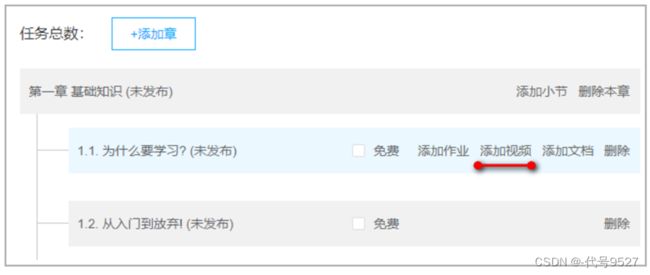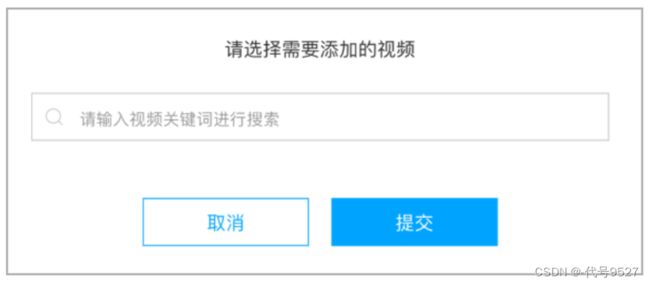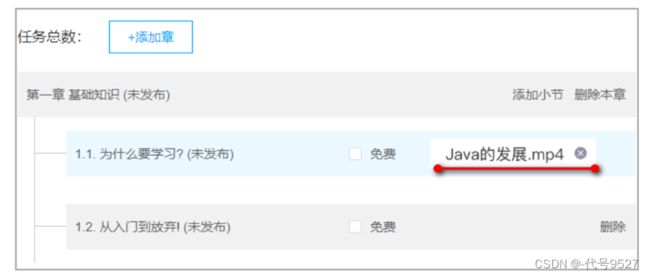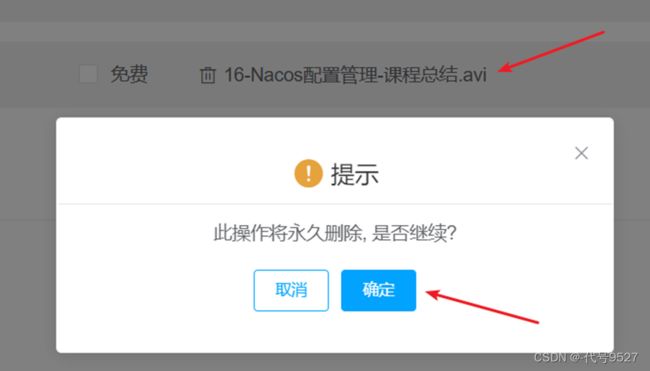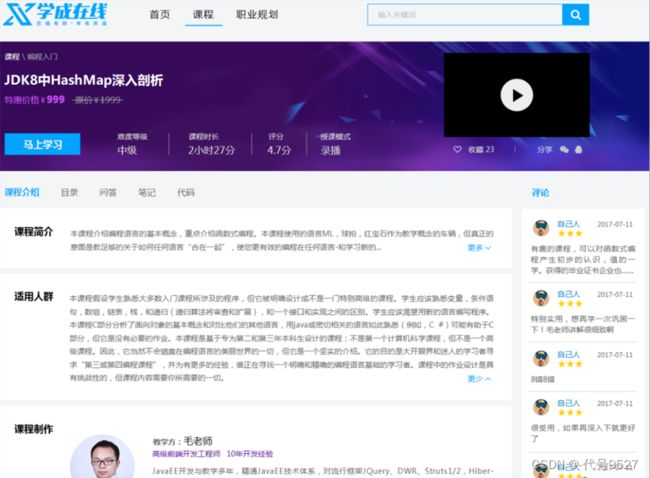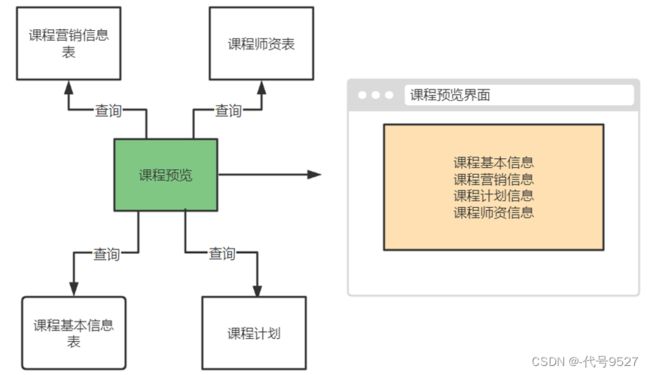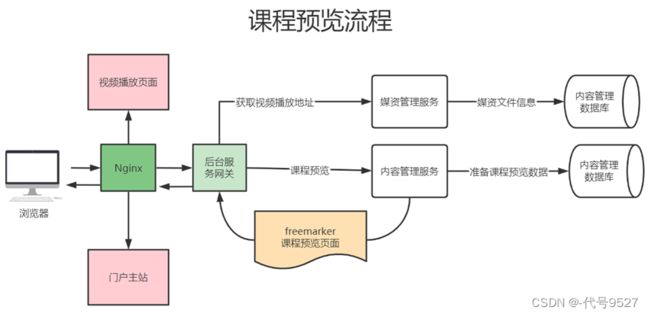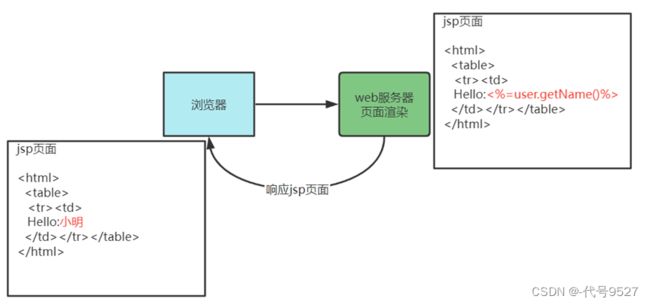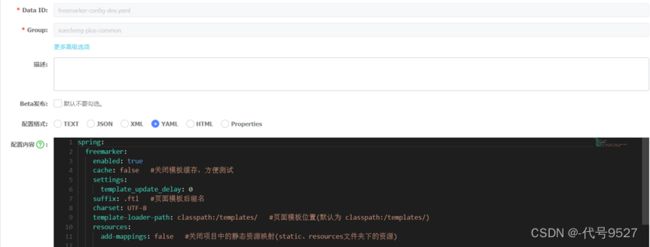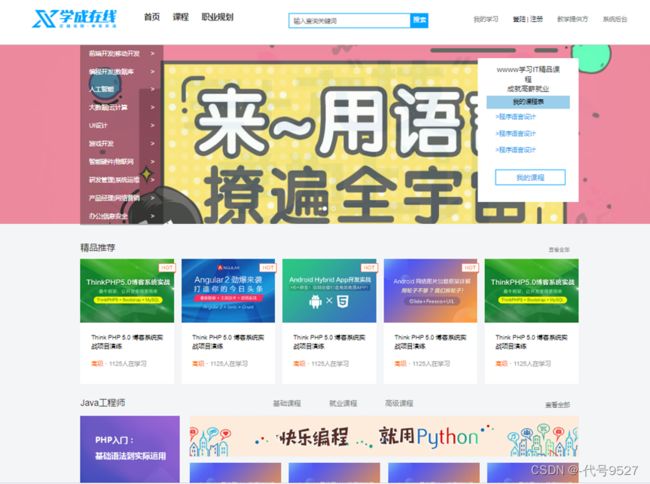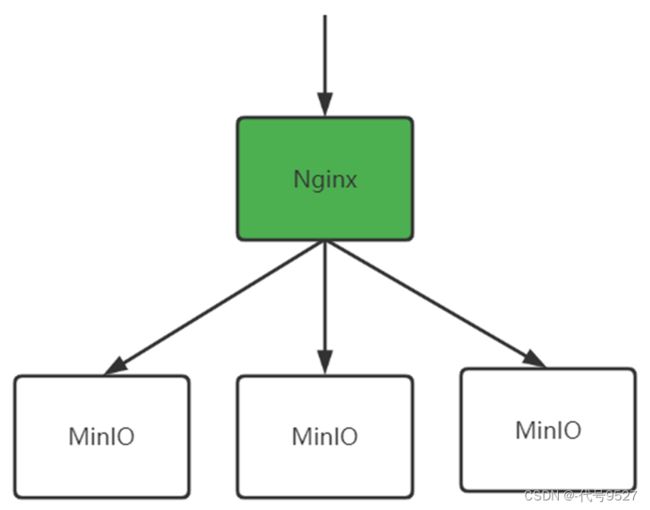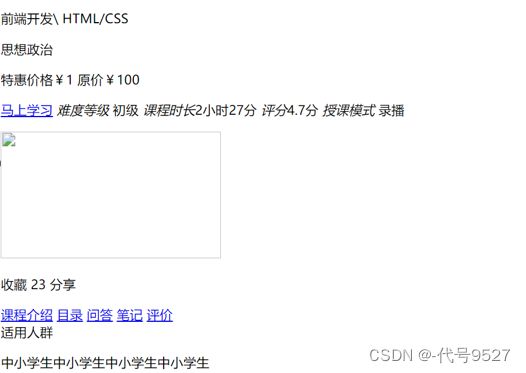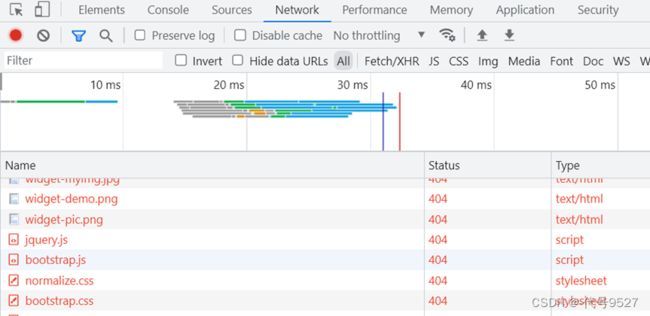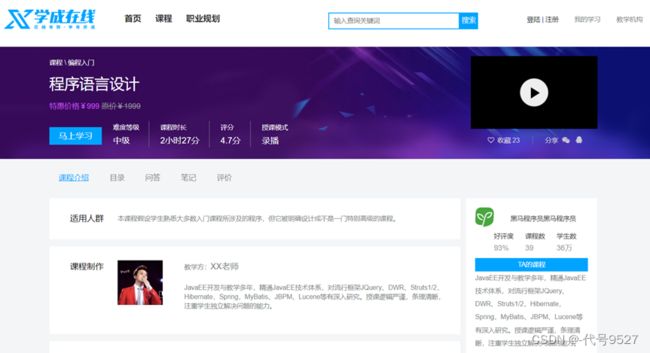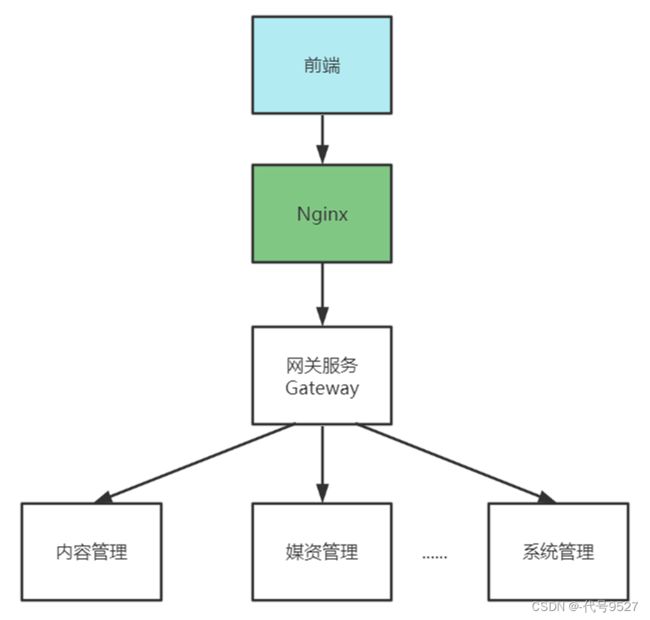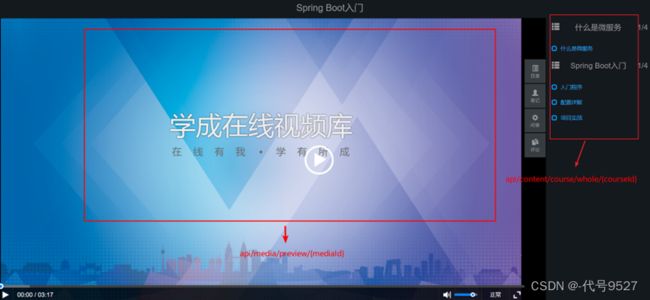【Java实战篇】Day6.在线教育网课平台
文章目录
- 一、需求:绑定媒资
-
- 1、需求分析
- 2、库表设计与模型类
- 3、接口定义
- 4、Mapper层开发
- 5、Service层开发
- 6、完善controller层
- 二、需求:课程预览
-
- 1、需求分析
- 2、实现技术
- 3、模板引擎
- 4、Freemarker入门
- 5、部署网站门户
- 6、接口定义
- 7、接口开发
- 8、编写模板
- 9、视频播放页面接口
一、需求:绑定媒资
1、需求分析
在前面完成视频的上传与转码处理后,需要将视频与教学计划进行绑定。UI如下:
2、库表设计与模型类
设计绑定媒资表teachplan_media:这种关联表通常记录双方主键即可。
前端传参:媒资文件id、文件名称、教学计划id
{
"mediaId": "70a98b4a2fffc89e50b101f959cc33ca",
"fileName": "22-Hmily实现TCC事务-开发bank2的confirm方法.avi",
"teachplanId": 257
}
定义对应的Dto类:
@Data
@ApiModel(value="BindTeachplanMediaDto", description="教学计划-媒资绑定提交数据")
public class BindTeachplanMediaDto {
@ApiModelProperty(value = "媒资文件id", required = true)
private String mediaId;
@ApiModelProperty(value = "媒资文件名称", required = true)
private String fileName;
@ApiModelProperty(value = "课程计划标识", required = true)
private Long teachplanId;
}
3、接口定义
在TeachplanController类中定义接口如下:
@ApiOperation(value = "课程计划和媒资信息绑定")
@PostMapping("/teachplan/association/media")
public void associationMedia(@RequestBody BindTeachplanMediaDto bindTeachplanMediaDto){
}
4、Mapper层开发
直接生成新增库表的PO类,并且定义Mapper接口,直接继承BaseMapper
5、Service层开发
接口定义:
/**
* @description 教学计划绑定媒资
* @param bindTeachplanMediaDto
*/
public TeachplanMedia associationMedia(BindTeachplanMediaDto bindTeachplanMediaDto);
实现新加接口:(这里涉及到若存在、先删除、后添加,需要加事务控制)
@Transactional
@Override
public TeachplanMedia associationMedia(BindTeachplanMediaDto bindTeachplanMediaDto) {
//业务逻辑校验
//教学计划id
Long teachplanId = bindTeachplanMediaDto.getTeachplanId();
Teachplan teachplan = teachplanMapper.selectById(teachplanId);
if(teachplan==null){
XueChengPlusException.cast("教学计划不存在");
}
Integer grade = teachplan.getGrade();
if(grade!=2){
XueChengPlusException.cast("只允许第二级教学计划绑定媒资文件");
}
//课程id
Long courseId = teachplan.getCourseId();
//若原先有绑定的,先删除原来该教学计划绑定的媒资
teachplanMediaMapper.delete(new LambdaQueryWrapper<TeachplanMedia>().eq(TeachplanMedia::getTeachplanId,teachplanId));
//再添加教学计划与媒资的绑定关系
TeachplanMedia teachplanMedia = new TeachplanMedia();
teachplanMedia.setCourseId(courseId);
teachplanMedia.setTeachplanId(teachplanId);
teachplanMedia.setMediaFilename(bindTeachplanMediaDto.getFileName());
teachplanMedia.setMediaId(bindTeachplanMediaDto.getMediaId());
teachplanMedia.setCreateDate(LocalDateTime.now());
teachplanMediaMapper.insert(teachplanMedia);
return teachplanMedia;
}
6、完善controller层
@ApiOperation(value = "课程计划和媒资信息绑定")
@PostMapping("/teachplan/association/media")
void associationMedia(@RequestBody BindTeachplanMediaDto bindTeachplanMediaDto){
teachplanService.associationMedia(bindTeachplanMediaDto);
}
----------------------------------------------------------------------------
----------------------------------------------------------------------------
接下来是课程发布模块:
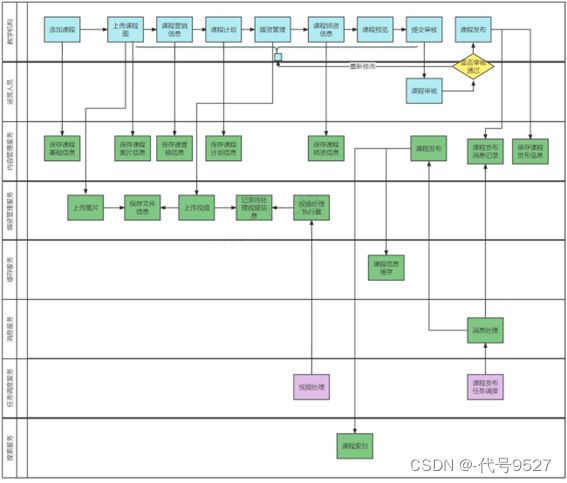
课程信息编辑完成后,接下来是发布课程。为了课程内容没有违规信息,需要平台运营方进行审核。而课程发布方(即教学机构)在课程发布前可通过预览功能看到课程发布后的效果。即课程发布模块包含三部分:
- 课程预览
- 课程审核
- 课程发布
----------------------------------------------------------------------------
----------------------------------------------------------------------------
二、需求:课程预览
1、需求分析
课程预览即整合课程的相关信息,在页面进行展示。UI图:
2、实现技术
- 点击课程预览,通过Nginx、后台服务网关请求内容管理服务进行课程预览
- 内容管理服务查询课程相关信息进行整合,并通过模板引擎技术在服务端渲染生成页面,返回给浏览器
- 通过课程预览页面点击”马上学习“打开视频播放页面
- 视频播放页面通过Nginx请求后台服务网关,查询课程信息展示课程计划目录,请求媒资服务查询课程计划绑定的视频文件地址,在线浏览播放视频
3、模板引擎
模板引擎是为了解决用户界面(显示)与业务数据(内容)分离而产生的。他可以生成特定格式的文档,常用的如格式如HTML、xml以及其他格式的文本格式。如早期的JSP:
- 浏览器请求web服务器
- 服务器渲染页面,渲染的过程就是向jsp页面(模板)内填充数据(模型)
- 服务器将渲染生成的页面返回给浏览器
所以模板引擎就是:
模板+数据=输出,Jsp页面就是模板,页面中嵌入的jsp标签就是数据,两者相结合输出html网页。
常用的java模板引擎有:
- Jsp
- Freemarker
- Thymeleaf
- Velocity 等
4、Freemarker入门
- 添加Freemarker与SpringBoot的整合包
<dependency>
<groupId>org.springframework.bootgroupId>
<artifactId>spring-boot-starter-freemarkerartifactId>
dependency>
spring:
freemarker:
enabled: true
cache: false #关闭模板缓存,方便测试
settings:
template_update_delay: 0
suffix: .ftl #页面模板后缀名
charset: UTF-8
template-loader-path: classpath:/templates/ #页面模板位置(默认为 classpath:/templates/)
resources:
add-mappings: false #关闭项目中的静态资源映射(static、resources文件夹下的资源)
DOCTYPE html>
<html>
<head>
<meta charset="utf-8">
<title>Hello World!title>
head>
<body>
Hello ${name}!
body>
html>
- 模板有了,编写controller方法,准备数据
import org.bouncycastle.math.raw.Mod;
import org.springframework.stereotype.Controller;
import org.springframework.web.bind.annotation.GetMapping;
import org.springframework.web.servlet.ModelAndView;
import java.util.Map;
/**
* @description freemarker测试
*/
@Controller //注意这里是controller
public class FreemarkerController {
@GetMapping("/testfreemarker")
public ModelAndView test(){
ModelAndView modelAndView = new ModelAndView();
//设置模型数据
modelAndView.addObject("name","小明");
//设置模板名称
modelAndView.setViewName("test");
return modelAndView;
}
}
5、部署网站门户
在课程预览界面上要加载css、js、图片等内容,这属于静态资源,通过部署nginx来访问。对于SpringBoot服务的动态资源由Nginx去代理请求,如下图:
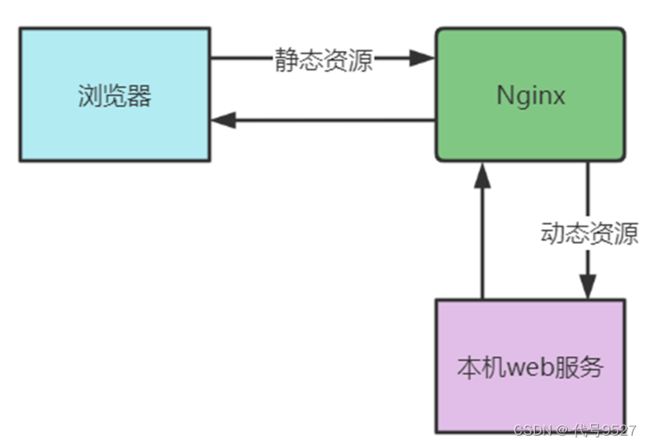
启动Nginx
- 下载 nginx-1.23.1.zip并解压
链接:https://pan.baidu.com/s/1Rc1EoxeOukVGYiFQO7UE4A?pwd=9yf2
提取码:9yf2
启动前端工程
-
解压包含静态资源的前端工程
-
在host文件中加入:
127.0.0.1 www.51xuecheng.cn 51xuecheng.cn
即访问这两个域名时,服务器IP是127.0.0.1
host文件位置:
window10操作系统hosts文件在C:\Windows\System32\drivers\etc下
Centos7操作系统的hosts文件在/etc目录下
------------------
hosts文件负责IP地址与域名快递解析,比如键入域名www.baidu.com,
首先会去看看hosts文件汇总有没有关于此域名IP地址的记录。如果有,就直接登陆该网站;
如果没有再查询DNS服务器
- 配置nginx.conf文件
server {
listen 80;
server_name www.51xuecheng.cn localhost;
#rewrite ^(.*) https://$server_name$1 permanent;
#charset koi8-r;
ssi on;
ssi_silent_errors on;
#access_log logs/host.access.log main;
location / {
alias D:/静态资源目录/xc-ui-pc-static-portal/;
index index.html index.htm;
}
文件服务器
课程预览时需要展示课程图片、视频等,而它们在MinIOn中存着,由Nginx代理,通过文件服务域名统一访问。
- 配置文件服务域名的服务器IP是localhost
127.0.0.1 file.51xuecheng.cn
- 在nginx.conf中配置文件服务器的代理地址
#文件服务
upstream fileserver{
#MinIOn的实际IP,权重无所谓,就一台
server 192.168.101.65:9000 weight=10;
}
server {
listen 80;
server_name file.51xuecheng.cn;
#charset koi8-r;
ssi on;
ssi_silent_errors on;
#access_log logs/host.access.log main;
location /video {
proxy_pass http://fileserver;
}
location /mediafiles {
proxy_pass http://fileserver;
}
}
以上即访问/video和/mediafiles都会代理到fileserver文件服务
-
重新加载nginx配置 nginx.exe -s reload
-
以后访问图片,直接通过文件域名http://file.51xuecheng.cn/mediafiles/{图片文件地址路径}
file.51xuecheng.cn解析为localhost
/mediafiles在localhost的nginx中会代理到文件服务192.168.101.65:9000
6、接口定义
课程预览接口需要:
- 在多张表中整合出课程预览需要的信息(数据)
- 使用模板引擎渲染出页面返回给浏览器
因此:
- 传参为:课程id,表示要预览哪一门课程
响应为:课程详情页面(注意返回的不再是json,而是页面)
要试用freemarker模板引擎,先把预览页面的模板course_template.html放到resources/templates下,起名course_template.ftl。
接下来定义预览接口:
@Controller
public class CoursePublishController {
@GetMapping("/coursepreview/{courseId}")
public ModelAndView preview(@PathVariable("courseId") Long courseId){
//先new一个模型视图对象
ModelAndView modelAndView = new ModelAndView();
//数据
modelAndView.addObject("model",null);
//指定模板,不用加扩展名,扩展名我写在了nacos配置中
modelAndView.setViewName("course_template");
return modelAndView;
}
}
注意这里,@RestController响应json,而@Controller可以响应页面。此时可以http://localhost:PORT/xxService/coursepreview/74 先看看效果:
看到:接口可以正常访问,而样式404。样式等静态资源在门户下,配置nginx反向代理来访问课程预览接口。
#后台网关
#这里直接配置代理到网关,由网关路由到不同服务
#单独配置一个个服务也行,但配置网关一劳永逸
upstream gatewayserver{
server 127.0.0.1:63010 weight=10;
}
server {
listen 80;
server_name www.51xuecheng.cn localhost;
....
#即所有以api开头的请求,统统进入网关
location /api/ {
proxy_pass http://gatewayserver/;
}
....
//改完后nginx.exe -s reload
此时通过域名访问:http://www.51xuecheng.cn/api/xxService/coursepreview/74
静态资源都有了,页面正常显示:(数据也是静态的,等后面实现接口)
目前的逻辑是:
- 先访问到nginx
- 以api开头,代理到Gateway网关
- 根据/xxService由网关路由到对应的服务
7、接口开发
使用freemarker渲染生成视图时需要数据模型,此数据模型包括了基本信息、营销信息、课程计划、师资等信息:
/**
* @description 课程预览数据模型
*/
@Data
@ToString
public class CoursePreviewVo {
//课程基本信息,课程营销信息
private CourseBaseInfoDto courseBase;
//课程计划信息
private List<TeachplanDto> teachplans;
//师资信息暂时不加...
}
定义Service接口:
public interface CoursePublishService {
/**
* @description 获取课程预览信息
* @param courseId 课程id
*/
public CoursePreviewVo getCoursePreviewInfo(Long courseId);
}
实现接口:
@Service
public class CoursePublishServiceImpl implements CoursePublishService {
@Autowired
CourseBaseInfoService courseBaseInfoService;
@Autowired
TeachplanService teachplanService;
@Override
public CoursePreviewVo getCoursePreviewInfo(Long courseId) {
//课程基本信息、营销信息
CourseBaseInfoDto courseBaseInfo = courseBaseInfoService.getCourseBaseInfo(courseId);
//课程计划信息
List<TeachplanDto> teachplanTree= teachplanService.findTeachplanTree(courseId);
CoursePreviewDto coursePreviewDto = new CoursePreviewDto();
coursePreviewDto.setCourseBase(courseBaseInfo);
coursePreviewDto.setTeachplans(teachplanTree);
return coursePreviewVo;
}
}
完善controller:
@Autowired
CoursePublishService coursePublishService;
@GetMapping("/coursepreview/{courseId}")
public ModelAndView preview(@PathVariable("courseId") Long courseId){
//获取课程预览信息
CoursePreviewVo coursePreviewInfo = coursePublishService.getCoursePreviewInfo(courseId);
ModelAndView modelAndView = new ModelAndView();
modelAndView.addObject("model",coursePreviewInfo);
modelAndView.setViewName("course_template");
return modelAndView;
}
8、编写模板
此时,接口已经可以拿到需要展示的数据,并返回。但模板course_template.ftl上还是写死的,要拿dollar大括号来接数据并填充。边写边调,改完course_template.ftl不用重启整个服务,直接编译:

需要IF–else或者其他语法的,参考官方文档http://freemarker.foofun.cn/ref_directives.html
<P> ${model.courseBase.mtName !''}P>
!''即如果前面拿到的值为null,则赋一个空字符串。
9、视频播放页面接口
- 课程计划的相关信息
- 视频播放地址
/open/content/course/whole/课程id
响应:同课程预览service接口返回数据
/open/media/preview/mediaId
响应:
{"code":0,"msg":"success","result":"视频的url","successful":true}
将这两个接口定义为open,对外开放(不用登录就能请求),nginx中加配置:
#openapi
location /open/content/ {
proxy_pass http://gatewayserver/content/open/;
}
location /open/media/ {
proxy_pass http://gatewayserver/media/open/;
}
专门定义openAPI的类CourseOpenController类:
@Api(value = "课程公开查询接口",tags = "课程公开查询接口")
@RestController
@RequestMapping("/open")
public class CourseOpenController {
@Autowired
private CourseBaseInfoService courseBaseInfoService;
@Autowired
private CoursePublishService coursePublishService;
@GetMapping("/course/whole/{courseId}")
public CoursePreviewVo getPreviewInfo(@PathVariable("courseId") Long courseId) {
//获取课程预览信息
CoursePreviewVo coursePreviewInfo = coursePublishService.getCoursePreviewInfo(courseId);
return coursePreviewInfo;
}
}
在媒资服务中定义另一个类MediaOpenController类:
@Api(value = "媒资文件管理接口",tags = "媒资文件管理接口")
@RestController
@RequestMapping("/open")
public class MediaOpenController {
@Autowired
MediaFileService mediaFileService;
@ApiOperation("预览文件")
@GetMapping("/preview/{mediaId}")
public RestResponse<String> getPlayUrlByMediaId(@PathVariable String mediaId){
MediaFiles mediaFiles = mediaFileService.getFileById(mediaId);
if(mediaFiles == null || StringUtils.isEmpty(mediaFiles.getUrl())){
MyException.cast("视频还没有转码处理");
}
return RestResponse.success(mediaFiles.getUrl());
}
}
